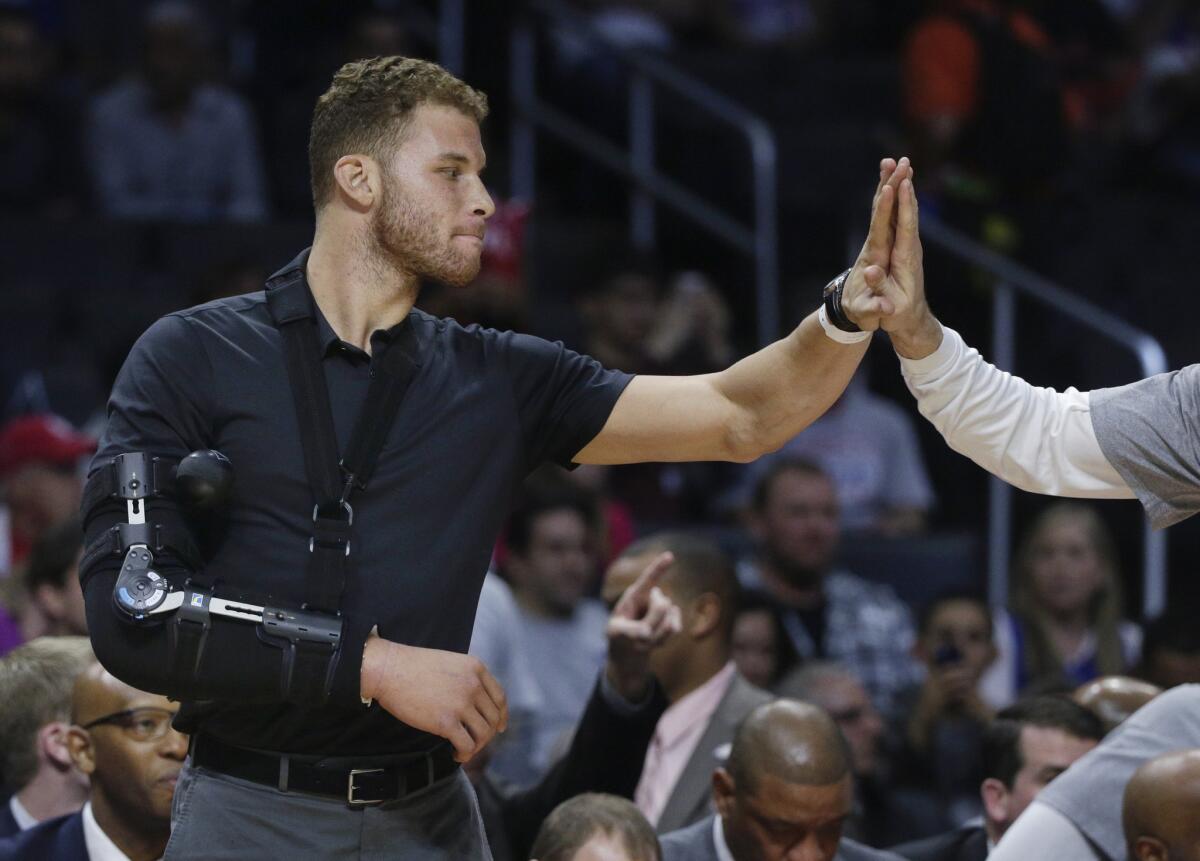Clippers’ Blake Griffin needs time to heal — completely

- Share via
The team with the coach named Doc is paying close attention to a potentially serious medical problem. As the Clippers should.
This isn’t about sprained ankles or back spasms. In the NBA, those are the ordinary costs of doing business.
This is about what had been festering in Blake Griffin’s right elbow, the one he had covered and wrapped under a long black sleeve Wednesday night, when he received his All-Star game award while dressed in street clothes.
Griffin, having a huge season for the Clippers and an All-Star selection of the fans, won’t play in the game Sunday. He had a staph infection in the elbow.
That doesn’t register deeply with most people. One Clippers official said Wednesday night that, since Griffin’s surgery last week, the question asked most often by fans and media is: When will he be back?
That’s understandable in one sense. He is a star, a player who can score from anywhere, who is instant excitement, whose dunks are not just dunks, but arena-shakers.
The question is also a bit uninformed.
Staph infections are serious things. Sometimes deadly. Most likely, Griffin will be fine. That he was at the game Wednesday night, sitting with his teammates on the bench and not hooked up to tubes feeding him antibiotics, is a very good thing.
But there are cautionary tales, all too many.
“My dad had double hip replacement in April [2005] and was just fine until about November of that year,” said J.T. Snow, former Angels and San Francisco Giants baseball star. “By January, he was gone.”
Jack Snow was 62. He was an All-American receiver at Notre Dame, an 11-year standout in the NFL with the Rams. He died because a staph infection got into the area around one of the titanium hip replacements and doctors could never stop it from spreading and taking over his body.
Once staph infections, and their even more dangerous cousin MRSA (methicillin-resistant Staphylococcus aureus), enter your body and your life, you never forget.
“I was watching ‘SportsCenter’ the other night,” J.T. Snow said. “I saw a crawl on the bottom of the screen, and I just saw ‘…out with a staph infection.…’ I rewound it and found out it was Blake. All the thoughts came right back.”
At the time of Jack Snow’s death, the Rams, perhaps following the usual NFL procedure of deflecting and denying anything that might cause legal problems, said that Snow had a sinus infection that became staph.
J.T. and his sisters, Michelle and Stephanie, disagreed with that at the time and J.T. still does.
“It’s a nasty deal,” he said. “It lives in weight rooms, in saunas, in AstroTurf, in whirlpools. There’s no doubt in my mind he got it there.”
Snow was a broadcaster for the St. Louis Rams at the time of his death. After his hip replacements, he spent a considerable amount of time in the Rams’ training facility, trying to get the hips back into shape. Around that time, several pro teams, including the Rams, had outbreaks of staph infections and their costly and complicated facility cleanups became a story.
“We had MRSA when I was with the Celtics,” Doc Rivers said Wednesday night. “I think it was a nonplayer who had been in there who had it. It was a mess. They brought in crews with masks to clean everything. I think they had to do it twice.”
In the media group covering the Clippers’ game against the Houston Rockets was a broadcaster named Eric Geller. Years ago, in Twin Falls, Idaho, he got MRSA after a blood-clot operation. He ended up in isolation for two months before they could cure it.
“I felt like a bubble boy, people all around me in things looking like spacesuits,” he said.
“It was the worst thing I ever went through.”
And then there was Grant Hill, now retired and himself a former Clipper. Without an ankle injury that disrupted his NBA career, Hill was, on a given night, one of the best players in the league.
It was surgery on that ankle in March 2003 that brought on a staph infection that so debilitated him that he missed the entire next season. At one point, his temperature was 104.5.
In a recent interview with The Times’ Melissa Rohlin and Broderick Turner, Hill was unequivocal about what he had gone through.
“That’s as close as I’ve ever come to checking out,” he said.
He also said, “It’s one of those things that you don’t know where it came from, but it could be deadly.”
J.T Snow, now a sports broadcaster in the Bay Area and a member of the Giants’ community relations team, had more than secondhand experience with staph.
“I got it when I was with the Giants,” he said. “We had a day off, I played golf. I woke up with a sore elbow, with kind of a ring around it. Not sure where or how I got it. Maybe reaching into a bush on the golf course. I used to get in the hot tub for a couple of minutes when I got to the ballpark. Maybe there. You just don’t know.”
He recovered quickly and returned to his pro career.
That’s exactly what the hope, the expectation, is for Griffin.
I type these words with help from the thumb with the surgical scar on it. That is the thumb that came within hours of not being there, had not some superb doctors concluded that the only way to get rid of the MRSA and save the thumb was to operate.
When they finished, they called their work a success. They also made sure I knew it could come back.
Again, the question at hand needs to be not when will Blake Griffin be back, but when will he be completely healthy?
Follow Bill Dwyre on Twitter @DwyreLATimes
More to Read
Go beyond the scoreboard
Get the latest on L.A.'s teams in the daily Sports Report newsletter.
You may occasionally receive promotional content from the Los Angeles Times.







